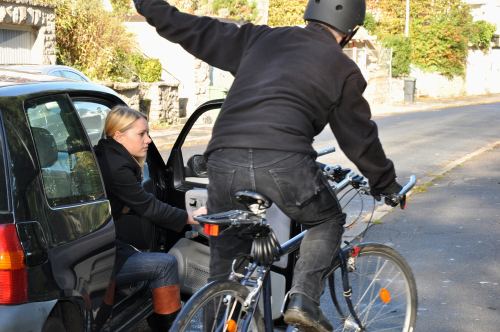Bicycle dooring accidents occur when cyclists collide with an open car door, usually after a driver or passenger opens it without checking for oncoming cyclists. These accidents can result in severe injuries for the cyclist, including broken bones, head injuries, and even death.
If you recently sustained injuries in a bicycle dooring accident that resulted from a vehicle driver's or passenger's negligence, you are not alone. A knowledgeable Atlanta bicycle accident attorney can swiftly investigate the circumstances surrounding your accident and develop a plan of action for moving forward. Your lawyer can then take legal steps to maximize the monetary compensation you recover.
How Do Dooring Accidents Happen?
There are several common scenarios in which dooring accidents happen, and they highlight why motor vehicle drivers or passengers are often at fault.
One typical scenario is when a driver parks on the side of a busy street and opens their door into the path of an approaching cyclist. Drivers often fail to look in their rearview or side mirrors before exiting their vehicle, assuming it is safe to open the door. This negligence can be due to distractions, such as being in a hurry, talking on a phone, or simply not being aware of their surroundings. In such cases, the driver's failure to check for cyclists before opening the door directly causes the accident.
Another scenario involves passengers in a parked car opening the door into the path of a cyclist. Passengers, especially those in the back seat, might be even less aware of oncoming cyclists than drivers. They may open the door abruptly without looking, sometimes because they are focused on exiting the car quickly or because conversations or activities inside the vehicle distract them. This lack of attention to their surroundings can lead to dooring accidents, making the passengers at fault.
In addition, dooring accidents can happen when a driver or passenger opens a door into a bike lane. Bike lanes are designated areas for cyclists, meant to provide a safer space away from motor vehicle traffic. However, when car occupants open doors into these lanes without looking, they effectively block the cyclist's path, leading to a collision. The responsibility lies with the driver or passenger to ensure the lane is clear before opening the door.
In all these scenarios, the common factor is the failure of the car occupant to check for cyclists before opening the door. This lack of vigilance is a form of negligence, as it disregards the safety of others on the road. Traffic laws in many places require drivers and passengers to ensure that it is safe before opening their doors, specifically to prevent dooring accidents. When drivers and passengers ignore these laws, and accidents happen, the fault typically lies with the car occupant for not taking the necessary precautions to avoid harming cyclists.
Injuries That Cyclists May Suffer in a Dooring Accident

Bicyclists involved in dooring accidents can suffer a range of injuries, some of which can be quite severe. The nature and extent of these injuries often depend on the cyclist's speed at the time of the collision, the force of the impact, and how the cyclist falls or is thrown as a result. Here are some of the most common injuries that bicyclists may experience in a dooring accident.
One of the most frequent injuries is broken bones. When a cyclist hits an open car door, the sudden stop can cause them to fall awkwardly, leading to fractures in the arms, wrists, or shoulders as they try to brace themselves. Clavicle (collarbone) fractures are particularly common because the impact often causes the cyclist to land on their shoulder.
Head injuries are another serious concern in dooring accidents. Even if a cyclist is wearing a helmet, the force of the impact can cause concussions or more severe traumatic brain injuries (TBIs). A concussion may result in symptoms like headaches, dizziness, and confusion, while more severe TBIs can have long-lasting effects on cognitive function and quality of life.
Facial injuries are also common in dooring accidents. The cyclist's face can strike the car door, the pavement, or their own handlebars, leading to cuts, bruises, dental injuries, and fractures to the nose, jaw, or cheekbones. These injuries can be particularly distressing due to the potential for permanent scarring and the need for extensive medical or dental treatment.
Road rash is a term used to describe the scrapes and bruises that occur when a cyclist slides across the pavement after a fall. These injuries can be quite painful and prone to infection if not properly treated. In some cases, deep abrasions can lead to scarring.
Finally, spinal injuries can occur if the cyclist falls in a way that twists or compresses the spine. This can result in anything from back pain to severe spinal cord injuries, which can lead to partial or complete paralysis.
A knowledgeable bicycle accident attorney in your area can gather documents and other important evidence while you focus your attention on making a full medical recovery.
Proving Negligence in a Bicycle Dooring Accident
Proving negligence in a dooring accident involves demonstrating that the driver or passenger failed to act with reasonable care, resulting in the bicyclist's injuries. There are four key legal elements of negligence that an injured bicyclist must establish: duty of care, breach of duty, causation, and damages.
- Duty of Care — The first element requires showing that the driver or passenger owed a duty of care to the bicyclist. Generally, all road users, including drivers and their passengers, have a responsibility to avoid causing harm to others. This includes checking for oncoming traffic, such as bicyclists, before opening car doors. Laws and regulations in many jurisdictions explicitly state that drivers and passengers must ensure it is safe before opening a car door into traffic or a bike lane.
- Breach of Duty — The next step is to demonstrate that the driver or passenger breached this duty of care. In a dooring accident, this breach occurs when the car occupant opens the door without properly checking for approaching bicyclists. Evidence that can help prove a breach of duty includes witness statements, video footage from nearby cameras, or even the bicyclist's account of the incident. If local traffic laws require drivers and passengers to look before opening doors, showing a violation of these laws also supports the claim of a breached duty.
- Causation — The third element is causation, which involves proving that the breach of duty directly caused the bicyclist's injuries. The injured bicyclist must show a clear link between the driver's or passenger's actions and the accident. Medical records documenting the injuries sustained in the collision can be vital evidence. In addition, photographs of the accident scene, damage to the bicycle, and the open car door can help establish this connection.
- Damages — Finally, the bicyclist must demonstrate that they suffered actual damages due to the accident. These damages can include medical bills, lost income, pain and suffering, and other costs associated with the injuries. Collecting and presenting documentation such as hospital bills, receipts for medication, and records of missed work can support the claim for damages.
With clear evidence supporting each of these elements, the injured bicyclist can make a strong case for negligence.
Settlement Negotiations in a Bicycle Dooring Accident Case
An experienced bicycle accident lawyer can be a crucial ally in handling settlement negotiations for a bicycle dooring accident case. With their skill and knowledge, they can navigate the legal proceedings and ensure you receive fair compensation for your accident-related losses. Here is how they can assist you throughout your case:
- Case Evaluation — First, a bicycle accident lawyer will thoroughly evaluate your case. They will review the accident details, gather evidence, and assess the extent of your injuries and damages. This may include collecting medical records, police reports, witness statements, and any available video footage. By understanding the full scope of your situation, the attorney can determine the value of your claim.
- Building a Strong Case — An attorney will build a strong case by proving the four elements of negligence: duty of care, breach of duty, causation, and damages. They will compile evidence to show that the driver or passenger was at fault for opening the door without checking for oncoming cyclists. This may involve consulting with accident reconstruction experts or medical professionals to provide expert testimony supporting your claim.
- Negotiation Skills— One of the most important roles of an attorney is to negotiate with the insurance companies on your behalf. Insurance adjusters often try to minimize payouts, but an experienced attorney knows the tactics they use and can counter them effectively. Your attorney will present a compelling argument for why you deserve a fair settlement based on the evidence and legal precedents.
- Communication and Documentation — An attorney will handle all communication with the insurance companies, ensuring that your statements are accurately represented and that you do not inadvertently say something that can harm your case. They will also manage all necessary paperwork, ensuring the correct filing of your claim within any applicable deadlines.
- Maximizing Compensation — Attorneys are skilled at maximizing the compensation you receive. They will account for all your current and future medical expenses, lost income, pain and suffering, and other related costs. By presenting a comprehensive assessment of your damages, they can push for a higher settlement amount.
- Litigation If Necessary — If the parties cannot reach a fair settlement through negotiations, an attorney is prepared to take your case to court. They will represent you in front of a judge and jury, using their knowledge and skills to advocate for your rights and secure the compensation you deserve.
Compensation for Injuries Suffered in a Bicycle Dooring Accident
Following a dooring accident, an injured bicyclist may be eligible to recover various types of compensation, depending on the specifics of the case and the extent of the injuries sustained. Understanding these types of compensation can help victims and their families know what to expect and ensure they seek all the damages they are entitled to. They include the following:
- Medical Expenses — One of the primary types of compensation is for medical expenses. These include the cost of emergency room visits, hospital stays, surgeries, doctor appointments, prescription medications, and any necessary rehabilitation or physical therapy. In cases where injuries require long-term care or result in permanent disabilities, future medical costs can also be included in the compensation.
- Lost Wages — If the injured bicyclist cannot work due to their injuries, they can seek compensation for lost income. This covers the income they would have earned during the time they were unable to work. For severe injuries that affect the victim's ability to work in the future, compensation may also include lost earning capacity, which accounts for the long-term repercussions on their career and income potential.
- Pain and Suffering — Compensation for pain and suffering addresses the physical pain and emotional distress the accident caused. This can be more challenging to quantify than medical expenses or lost income, but it is an important aspect of the overall compensation. The severity of the injuries, the effects on the victim's daily life, and the length of recovery time are all factors determining the amount for pain and suffering.
- Property Damage — The bicyclist can also receive compensation for any damage to their bicycle and other personal property. This includes the cost of repairing or replacing the bicycle and any damaged clothing, helmets, or other equipment. If the accident caused the bicyclist to lose other personal items, such as a phone or watch, these may also be part of the compensation.
- Out-of-pocket Expenses — Any additional out-of-pocket expenses directly related to the accident can be compensable. These may include transportation costs for medical appointments, home modifications required due to injuries, and other incidental costs that arise as a result of the accident.
- Loss of Consortium — In some cases, the victim may receive compensation for loss of consortium, which refers to the negative effects the injuries have on the victim's relationship with their spouse or family. This can include the loss of companionship, support, and intimacy that the injured person's loved ones experience as a result of the accident.
- Punitive Damages — In cases where the at-fault party's actions were particularly reckless or egregious, the victim may pursue punitive damages. These intend to punish the wrongdoer and deter similar behavior in the future.
Speak to a Knowledgeable Bicycle Accident Lawyer Today
If you recently suffered injuries in a bicycle dooring accident, it is important that you retain a skilled bicycle accident attorney in your jurisdiction as soon as possible. Your Atlanta bicycle accident attorney can properly file a claim or lawsuit on your behalf, negotiate with settlement adjusters, or litigate your case to pursue the fair compensation you need to recover for your losses.
Schedule a Free Initial Consultation Today!




























